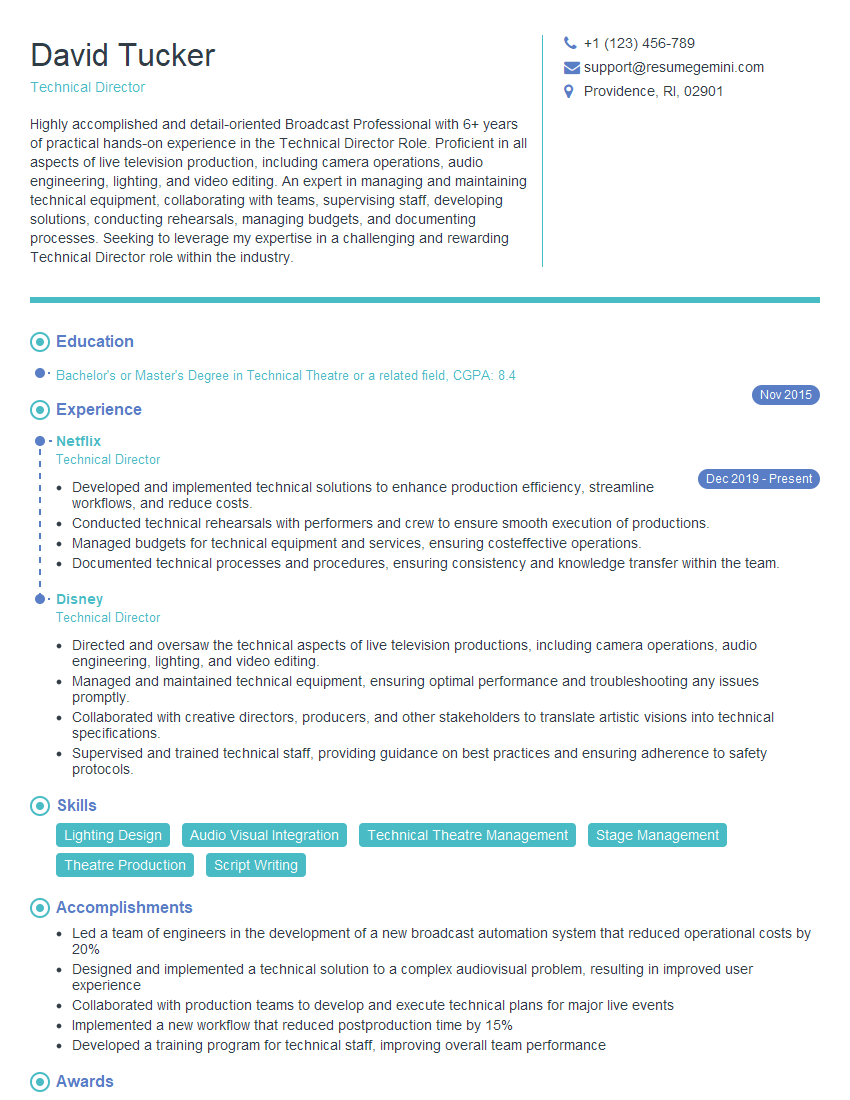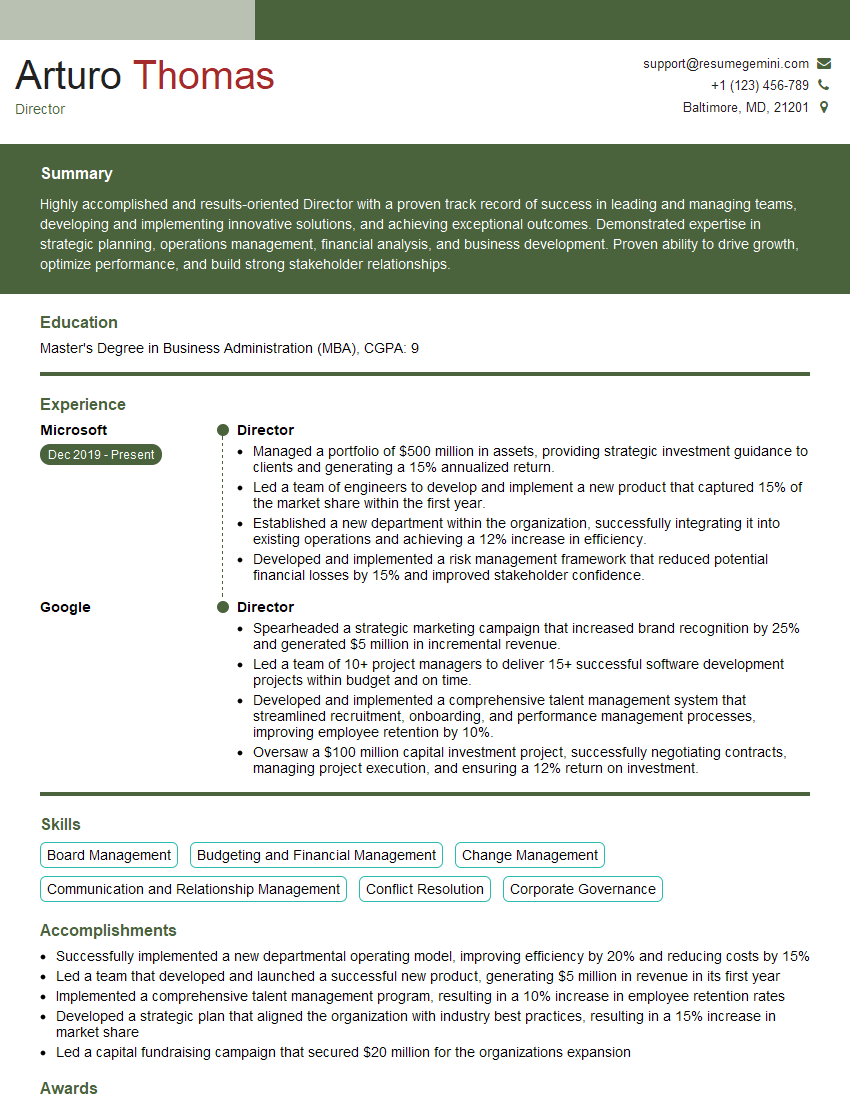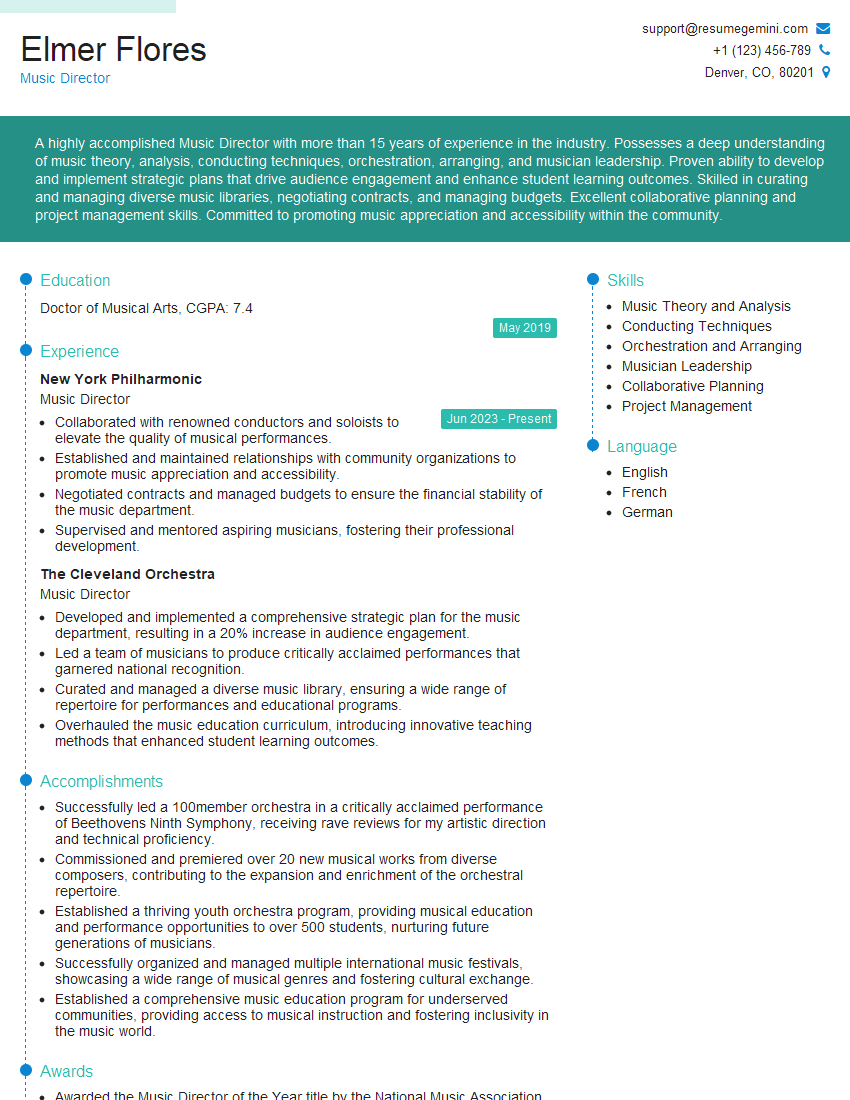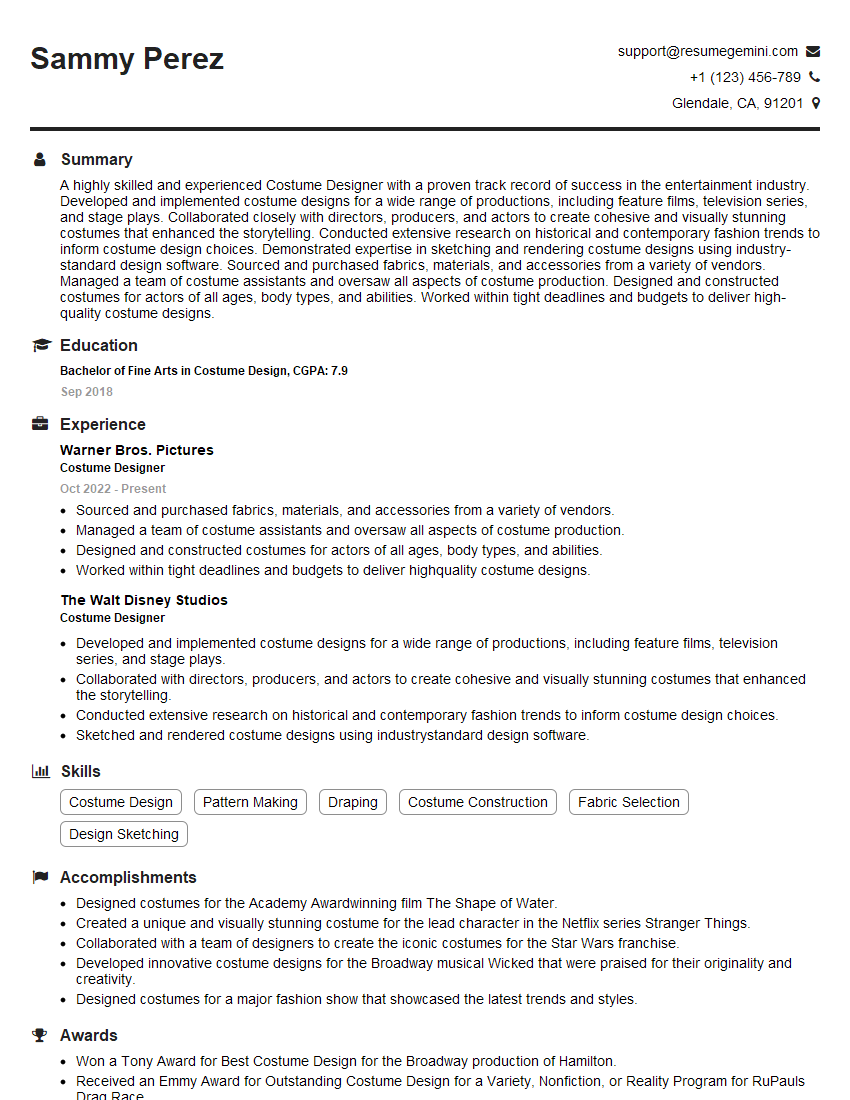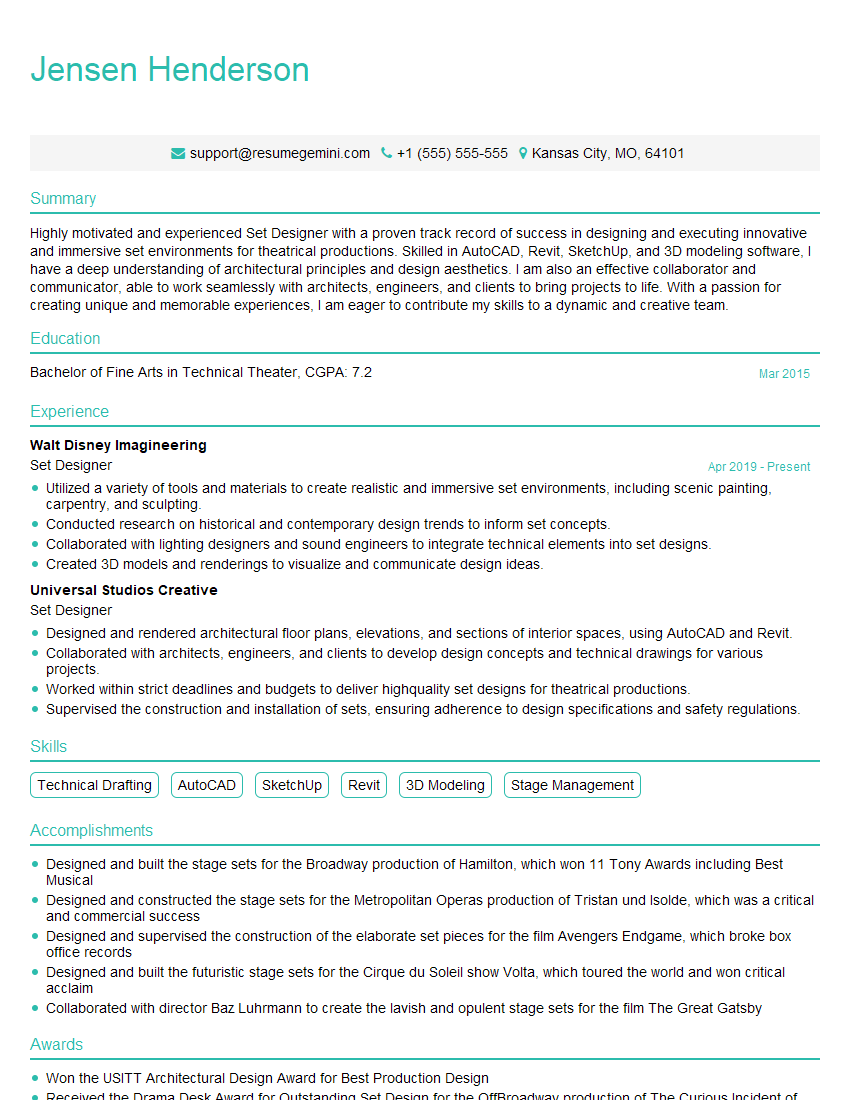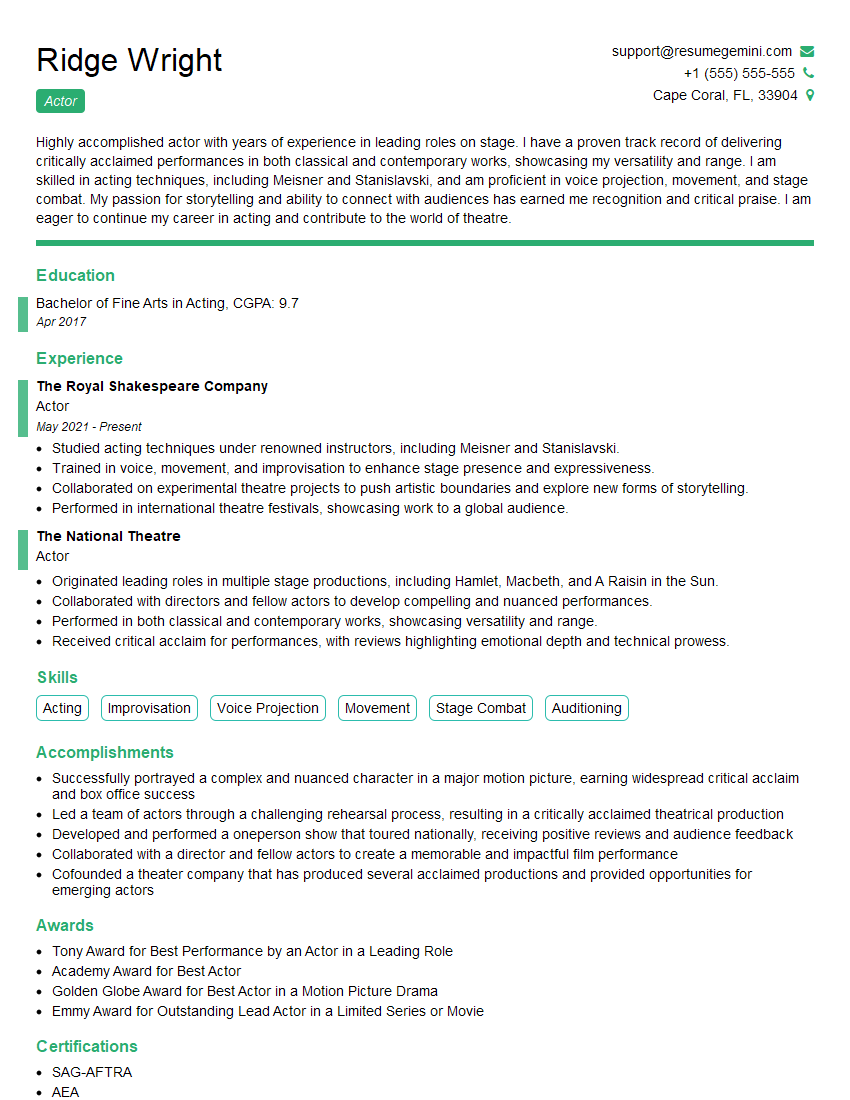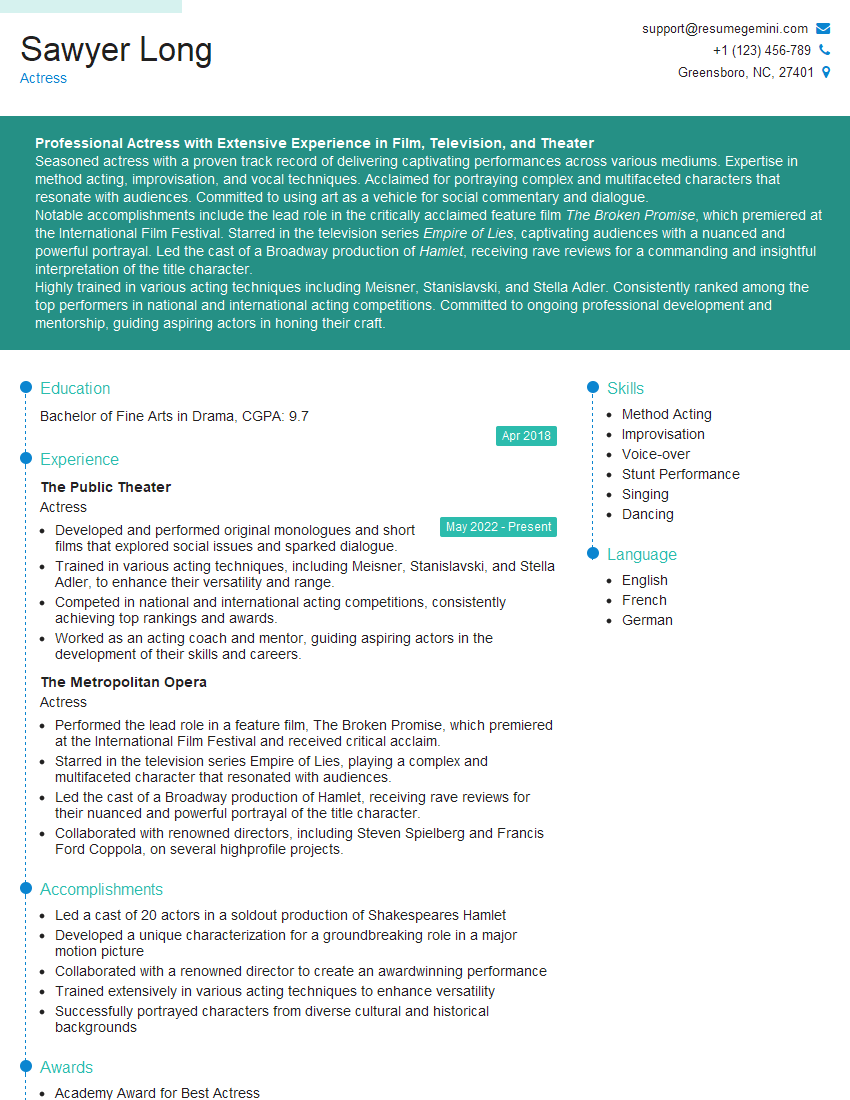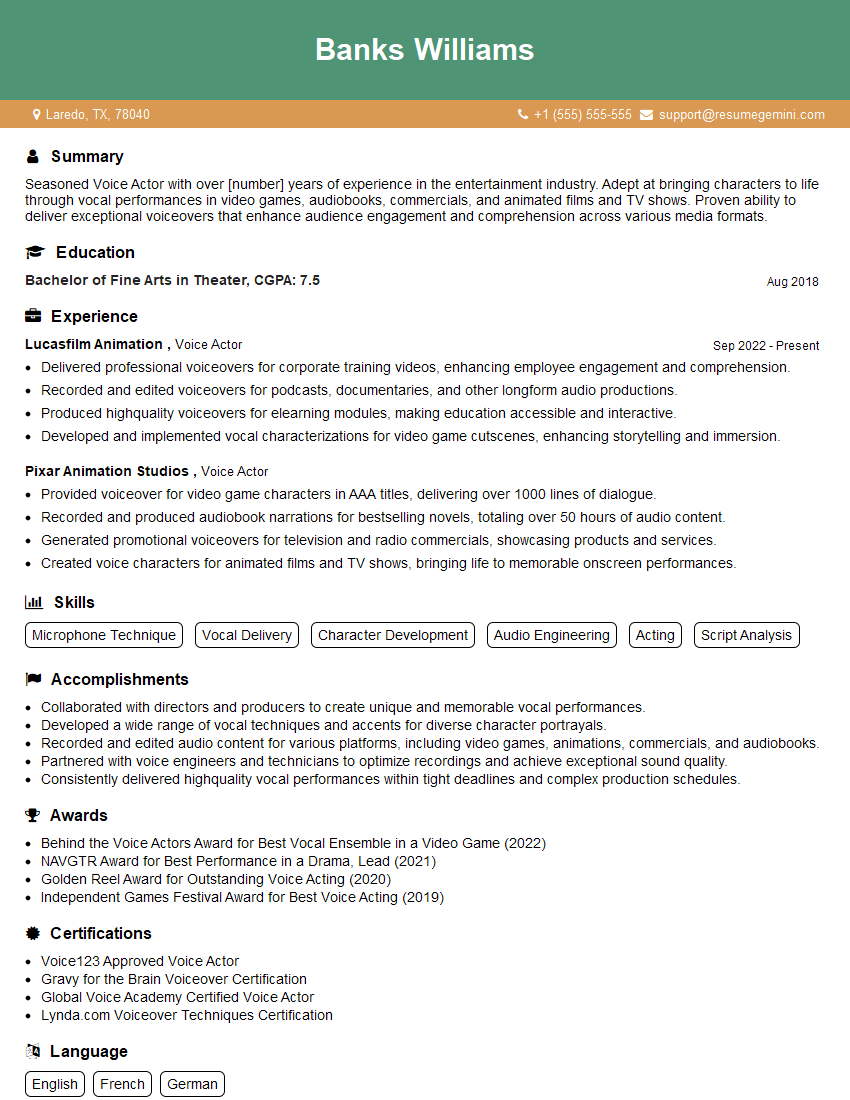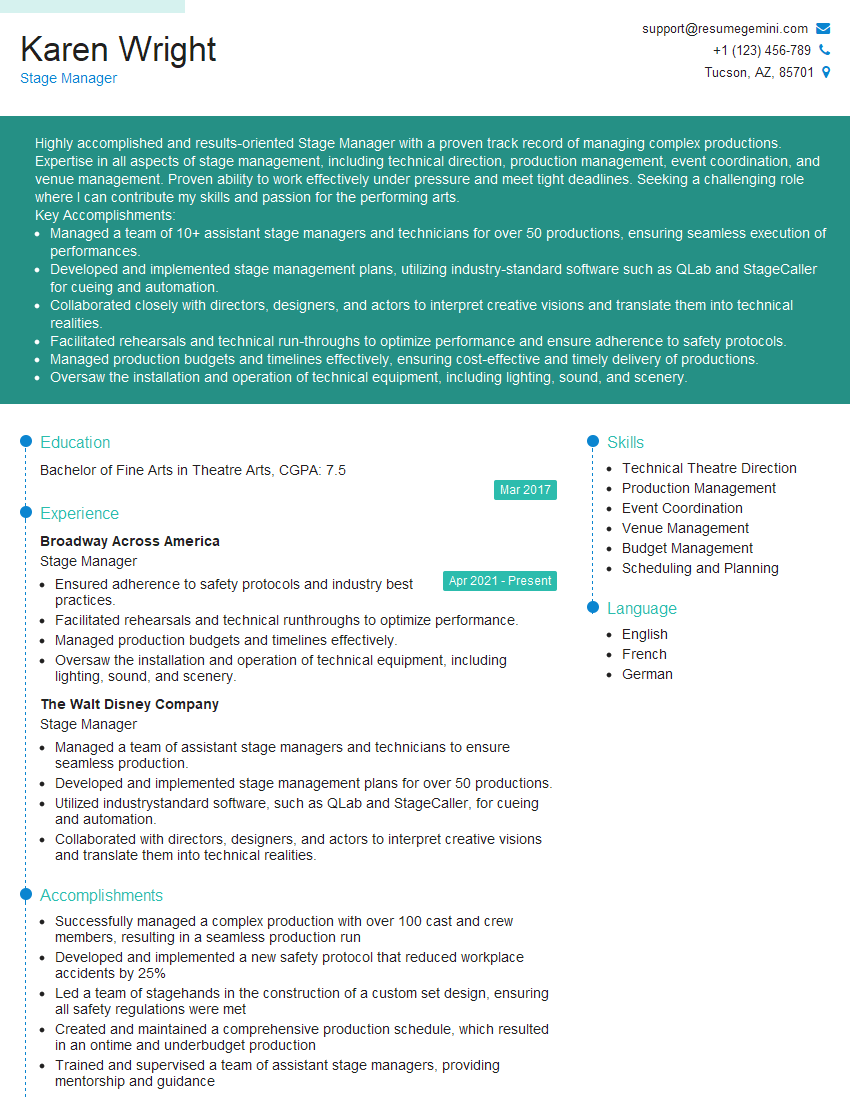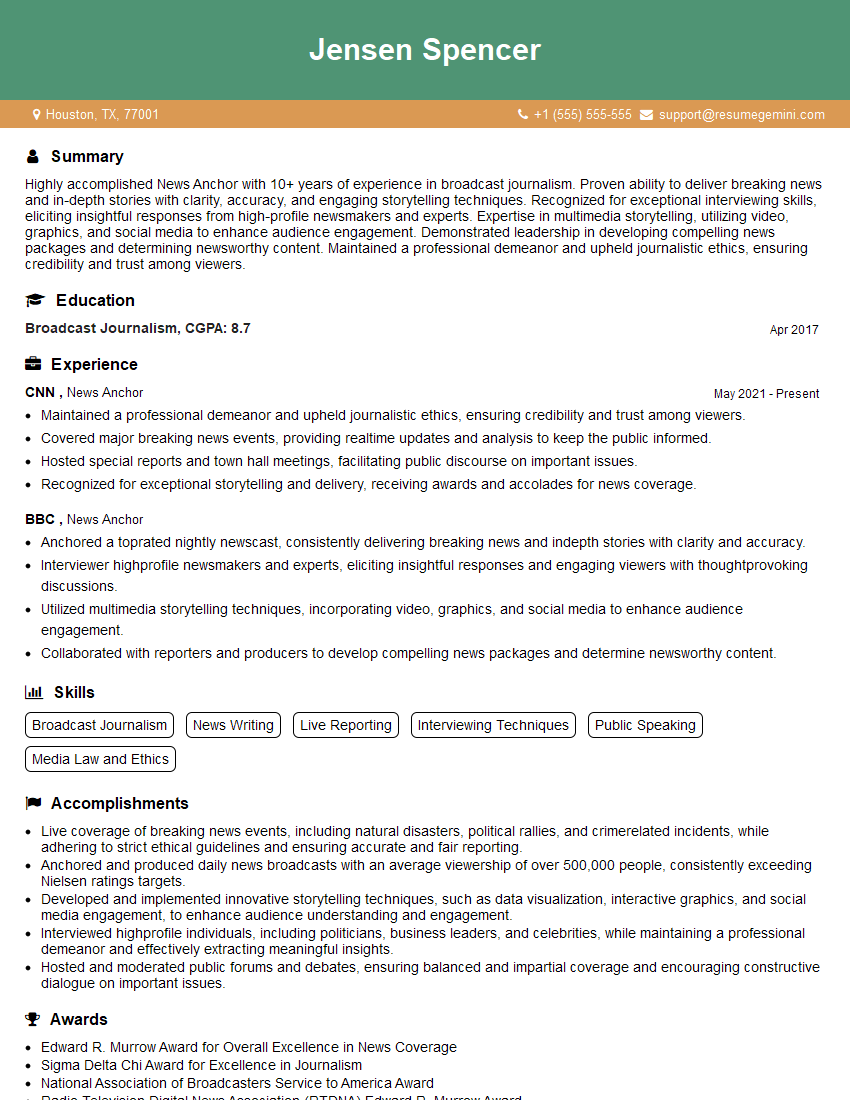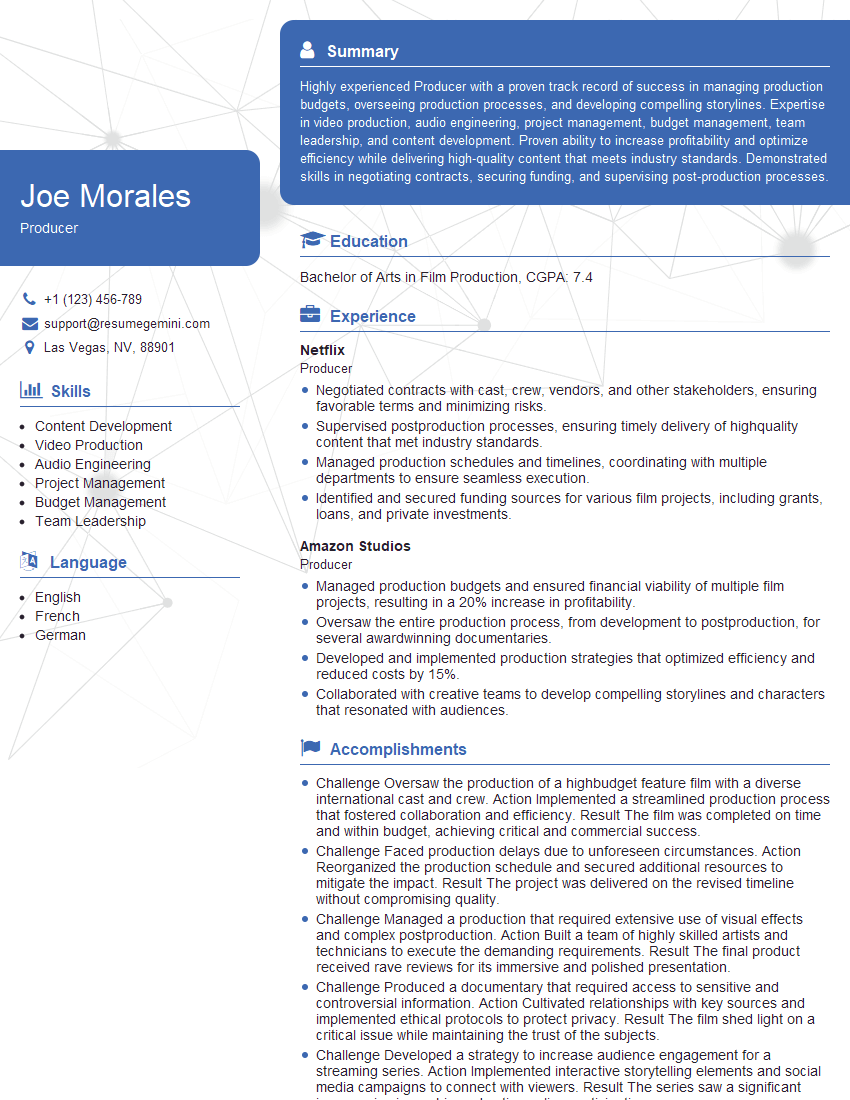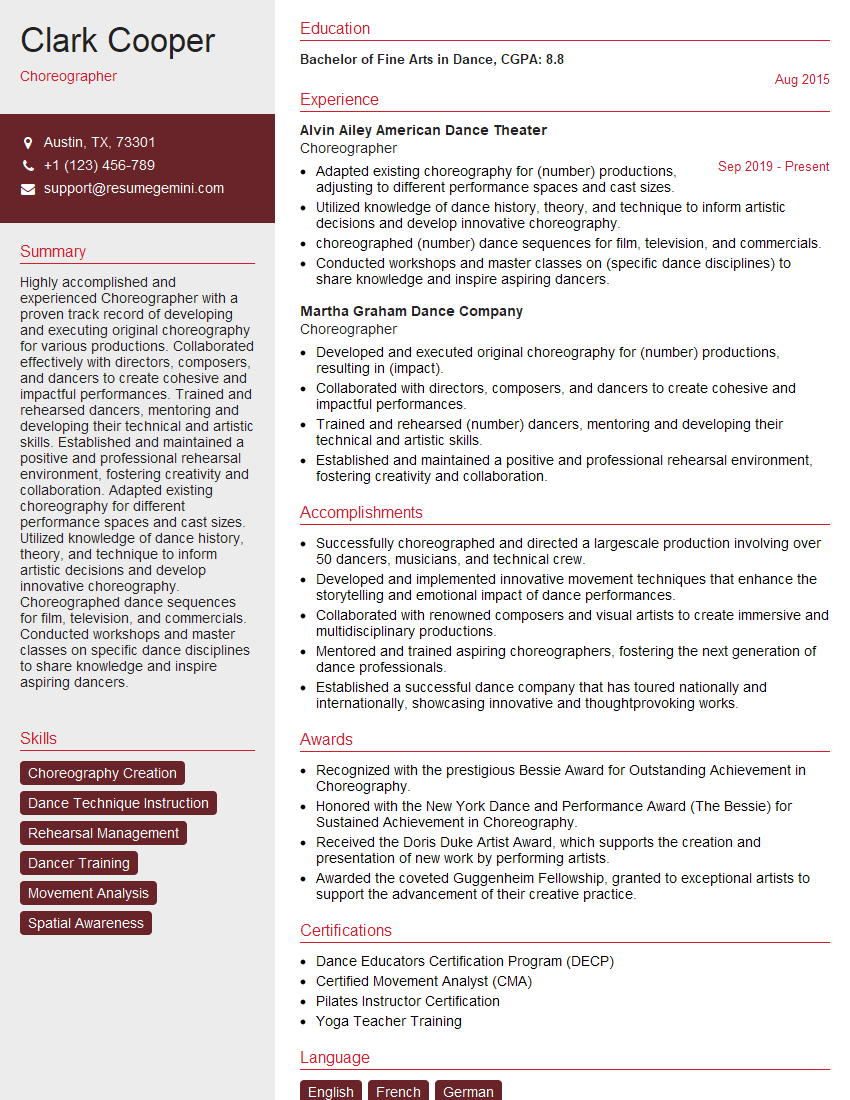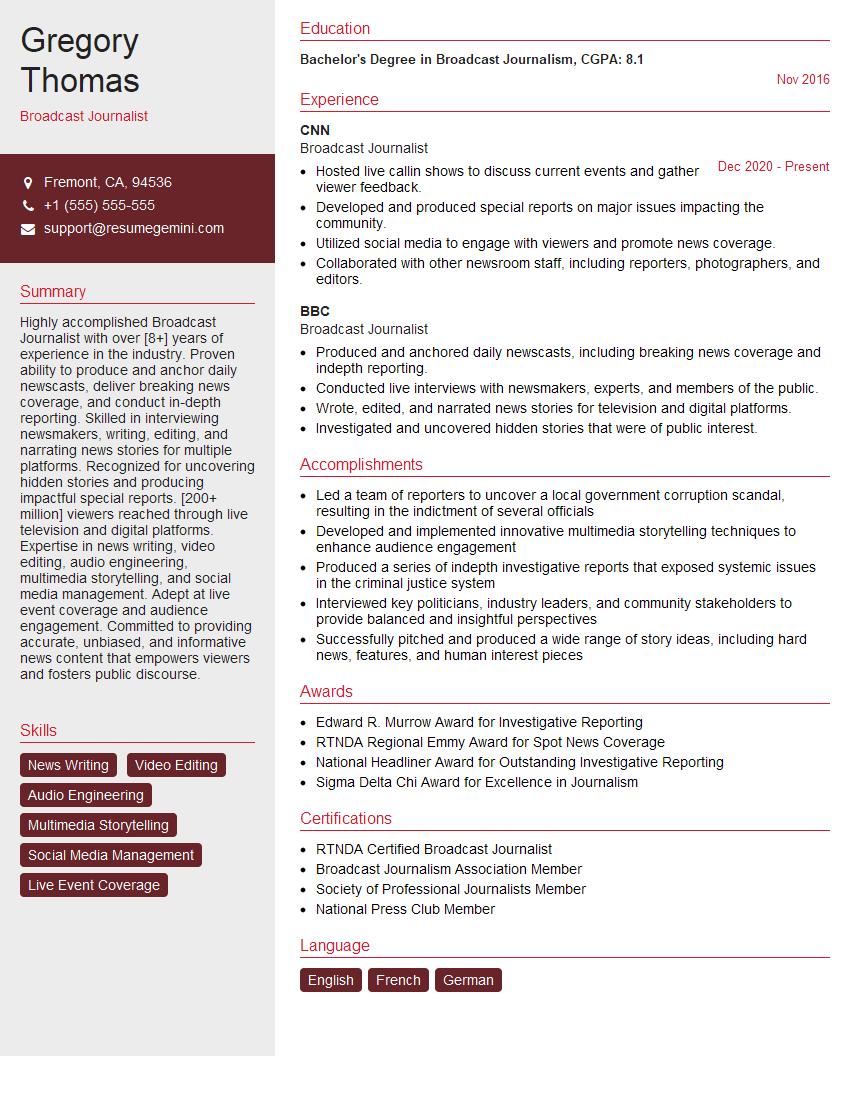Every successful interview starts with knowing what to expect. In this blog, we’ll take you through the top Experience in various performance settings, such as theatre, education, or broadcasting interview questions, breaking them down with expert tips to help you deliver impactful answers. Step into your next interview fully prepared and ready to succeed.
Questions Asked in Experience in various performance settings, such as theatre, education, or broadcasting Interview
Q 1. Describe your experience working with diverse teams in a performance setting.
Working with diverse teams in performance is crucial for success. It’s not just about different personalities, but leveraging the unique skills and perspectives each person brings. My experience spans from collaborative theatre productions with actors, musicians, and technicians, to educational workshops involving students of various ages and learning styles, and even live broadcasts with on-air talent, producers, and technical crews.
- Theatre: In a recent Shakespearean production, our cast included actors from diverse cultural backgrounds. To ensure accurate and sensitive portrayals, we held workshops led by cultural experts. This collaboration fostered a deeper understanding and enriched the performance.
- Education: During a series of educational workshops on improv, I worked with students with varying levels of confidence and experience. I adapted my teaching style to cater to their individual needs, providing more support to shy students while challenging the more experienced ones. This created an inclusive and engaging learning environment.
- Broadcasting: In a live morning show, we had a team composed of writers, producers, camera operators, and on-air personalities. Effective communication and clear roles were essential to a successful broadcast. Our weekly team meetings allowed us to address concerns, brainstorm ideas, and ensure everyone was aligned on the show’s objectives.
Successful collaboration relies on clear communication, mutual respect, and a willingness to learn from each other. By embracing diversity, we create a richer, more dynamic, and ultimately more successful performance.
Q 2. Explain your process for managing time constraints and meeting deadlines in a high-pressure environment.
Managing time constraints in high-pressure environments is a skill honed through experience. My approach is structured, prioritizing tasks, and utilizing efficient time management techniques.
- Prioritization: I use a combination of task lists and scheduling tools to identify crucial tasks and deadlines. The most time-sensitive items always take precedence. I break down larger projects into smaller, manageable chunks.
- Efficient Workflow: I meticulously plan rehearsals and broadcasts, allocating specific time blocks for each activity. This includes buffer time to account for unexpected delays. Using checklists helps prevent overlooking crucial steps.
- Communication: Open communication with my team is crucial. Keeping everyone informed of deadlines and progress ensures that everyone is working effectively towards a common goal. This prevents bottlenecks and ensures we’re all on the same page.
For example, during a live TV broadcast with multiple segments and a tight schedule, meticulous planning of each segment, clear communication with the director and on-air talent, and swift problem-solving during technical difficulties were key in meeting the tight broadcast deadlines. Thinking ahead and anticipating potential issues helps avoid unnecessary stress and delays.
Q 3. How do you adapt your performance style to different audiences or mediums?
Adapting my performance style is vital for connecting with diverse audiences and mediums. It’s about understanding the context and tailoring my approach to resonate effectively.
- Audience Analysis: Before any performance, I consider the audience’s demographics, expectations, and background. A children’s theatre performance requires a different approach than a lecture for university students. A formal broadcast demands a different tone than a casual online presentation.
- Medium Considerations: The medium itself greatly influences performance style. A stage performance relies on physicality and vocal projection. A radio broadcast requires a different vocal style. A video presentation demands effective screen presence and visual aids.
- Flexibility and Improvisation: Even with careful preparation, unexpected situations arise. Being flexible and able to adapt to changing circumstances is crucial. The ability to improvise within the confines of the performance goals is a valuable asset.
For instance, when presenting educational material to a diverse audience, I adapt my language to avoid jargon, use varied teaching methods, and encourage active participation. On a live radio show, I need to speak clearly and concisely, maintaining audience engagement through vocal tone and pacing. Adaptability is key to effective communication across any platform.
Q 4. Describe a time you had to overcome a technical challenge during a performance.
During a live theatre production, our primary sound system failed minutes before curtain call. This was a major setback, threatening the entire performance.
Problem-Solving Process:
- Immediate Assessment: We quickly assessed the situation, identifying the exact problem – a power surge had fried the main mixer.
- Alternative Solutions: We had a backup system, a smaller, less powerful one, but it required a quick reconfiguration of the sound design. We also needed to adjust the microphone placements to maximize the capabilities of the backup.
- Teamwork and Collaboration: The sound technician, stage manager, and director worked collaboratively to swiftly implement the alternative solution. The actors were briefed on the changes.
- Execution and Monitoring: We successfully implemented the alternative system. During the performance, the sound technician and stage manager continually monitored the system and made subtle adjustments as needed.
While the sound quality wasn’t ideal, we managed to avoid a complete shutdown. The audience was unaware of the technical difficulties, and the show continued without major disruption. This experience taught me the importance of meticulous planning, having backup plans, and effective teamwork in handling critical situations.
Q 5. How do you handle constructive criticism and feedback on your performance?
Constructive criticism is invaluable for growth. I welcome feedback as an opportunity to refine my performance.
- Active Listening: I listen attentively to the feedback, focusing on the specific points raised and avoiding defensiveness.
- Seeking Clarification: If I don’t understand something, I ask clarifying questions. This ensures I fully grasp the critique.
- Self-Reflection: After receiving feedback, I take time to reflect on the comments, considering how valid they are and how I can apply them to future performances.
- Actionable Steps: I identify specific, actionable steps I can take to address the feedback. This may involve technical adjustments, changes in performance style, or refining certain aspects of delivery.
For example, after a broadcast, I received feedback about my pace being too fast at times. By consciously slowing down and incorporating pauses, I improved the clarity and impact of my presentations in subsequent broadcasts. I embrace feedback as a tool for continuous improvement.
Q 6. What strategies do you use to maintain energy and focus during a long performance or broadcast?
Maintaining energy and focus during long performances or broadcasts requires a multifaceted approach.
- Physical Preparation: Proper sleep, nutrition, and hydration are essential. I avoid heavy meals before a performance and ensure I stay well-hydrated throughout.
- Mental Preparation: Mindfulness techniques such as meditation or deep breathing exercises can help reduce stress and improve focus.
- Strategic Breaks: During long performances, I take short, strategic breaks to rest, rehydrate, and mentally regroup. These pauses can significantly enhance performance quality and stamina.
- Audience Engagement: Connecting with the audience can invigorate and sustain energy. Making eye contact, interacting with the audience, and gauging their reactions can be energizing.
- Positive Self-Talk: Using positive self-talk and reminding myself of my goals can help maintain a positive mental attitude and focus.
During a six-hour live broadcast, for instance, short breaks for hydration and brief mental exercises helped sustain my energy levels and concentration. Maintaining audience connection through storytelling and improvisation also helped in keeping both myself and the audience engaged.
Q 7. Describe your experience using specific performance software or technologies.
My experience with performance software and technologies is extensive and spans various platforms.
- Audio Editing Software: I’m proficient in Audacity and Adobe Audition for audio editing, mastering, and sound design. I’ve used these tools for creating soundtracks for theatre productions and for audio editing in broadcasting contexts.
- Video Editing Software: I have experience with Adobe Premiere Pro and Final Cut Pro for video editing and post-production. These skills have been invaluable in creating video presentations, editing broadcast footage, and enhancing online educational materials.
- Teleprompter Software: I’m experienced using teleprompter software for live broadcasts and presentations. This skill ensures smooth and professional delivery of pre-written content.
- Streaming Platforms: I have experience utilizing platforms such as OBS Studio and Streamlabs for live streaming events, showcasing technical expertise in setting up and managing live broadcasts.
For instance, in a recent theatre production, I utilized Audacity to create and edit sound effects to enhance the atmosphere and narrative. In a live broadcast, I used a teleprompter to accurately deliver the script while maintaining eye contact with the camera. My skills in these software packages contribute significantly to the efficiency and quality of my performance projects.
Q 8. How do you ensure the accuracy and consistency of your performance?
Ensuring accuracy and consistency in performance is paramount. It’s a multifaceted process that begins long before stepping onto the stage or in front of the camera. It involves meticulous preparation, rigorous rehearsal, and a commitment to understanding the nuances of the role and the overall production.
- Script Mastery: For scripted performances, this means thoroughly memorizing lines, understanding subtext and character motivations, and integrating physicality and vocal delivery to enhance the storytelling.
- Character Development: I invest significant time in researching the historical context, social dynamics, and psychological profile of my character. This includes creating detailed backstories, exploring relationships with other characters, and defining their unique mannerisms and emotional range. For instance, playing Lady Macbeth required deep exploration of ambition, guilt, and madness to portray her believable descent.
- Rehearsal & Feedback: Rehearsals are crucial for refining the performance and identifying areas for improvement. I actively seek feedback from directors, fellow actors, and technical crew to ensure consistency and accuracy in delivery and interpretation.
- Physical & Vocal Warm-up: Maintaining physical and vocal health is essential. A consistent warm-up routine ensures peak performance and minimizes the risk of injury or vocal strain. Think of it like athletes warming up before a competition; it’s critical for optimal performance.
Q 9. How do you collaborate with other professionals in a performance setting?
Collaboration is the lifeblood of any successful performance. It’s a process of shared creativity and mutual support, requiring effective communication and respect for each other’s contributions.
- Active Listening: I actively listen to the director’s vision, the feedback from my fellow actors, and the technical crew’s suggestions. Open communication is essential.
- Shared Goals: Establishing shared goals and expectations from the outset is key. Open discussion about character interpretations, scene blocking, and overall production style helps ensure a unified approach.
- Compromise and Adaptability: Collaboration often requires compromise. I am willing to adapt my approach based on constructive criticism and feedback, always prioritizing the overall success of the production.
- Support and Encouragement: A supportive and encouraging environment fosters creativity. I strive to create an atmosphere where everyone feels comfortable sharing ideas and concerns.
- Example: In a recent theatre production, collaborating with the costume designer allowed us to create a costume that perfectly reflected my character’s personality and social status. The back-and-forth resulted in a far more impactful performance than I could have achieved alone.
Q 10. What methods do you use to monitor and evaluate the effectiveness of your performance?
Monitoring and evaluating performance effectiveness involves a blend of self-reflection, audience feedback, and professional critique.
- Self-Reflection: After each performance, I take time to reflect on my own strengths and weaknesses. Video recordings are invaluable for identifying areas needing improvement.
- Audience Feedback: Gathering audience feedback through surveys, informal conversations, and social media can provide valuable insights into how the performance resonated with the audience.
- Professional Critique: Seeking feedback from directors, fellow actors, and critics provides a professional perspective on the effectiveness of the performance. This often reveals aspects overlooked during self-reflection.
- Data Analysis (where applicable): In broadcasting, metrics like audience ratings and social media engagement offer quantifiable data on performance reach and impact.
- Iterative Improvement: I use feedback to iteratively improve my performances. Each performance is a learning opportunity, informing future preparations and execution.
Q 11. Explain your experience with different performance styles (e.g., improvisational, scripted).
My experience encompasses both scripted and improvisational performance styles. Each demands a unique set of skills and approaches.
- Scripted Performances: These involve detailed character development, script memorization, and precise delivery. My work in theatre productions exemplifies this, requiring rigorous rehearsal and collaboration with the director and fellow actors.
- Improvisational Performances: Improvisation requires quick thinking, adaptability, and strong listening skills. I’ve participated in improv workshops and comedy shows, where the emphasis is on spontaneity, creativity, and audience interaction.
- Blending Styles: Sometimes, performances blend scripted and improvised elements. For instance, in some educational settings, a structured lesson plan might incorporate spontaneous interactions with students based on their questions and responses. Adaptability is key in such cases.
Q 12. Describe your understanding of audience engagement in various performance settings.
Audience engagement is vital across performance settings. It’s not just about putting on a show; it’s about creating a connection and shared experience.
- Theatre: In theatre, engagement involves creating believable characters, utilizing strong physicality and vocal projection, and incorporating moments of audience interaction. Direct eye contact, clear articulation, and compelling storytelling are crucial.
- Education: Educational settings require a different approach. Engagement involves making the subject matter relatable, using interactive activities, and tailoring the presentation to the audience’s knowledge level and learning styles.
- Broadcasting: Broadcasting requires understanding the medium and tailoring the performance accordingly. This includes using clear and concise language, dynamic presentation, and visual aids to maintain audience attention.
- Connecting Emotionally: No matter the setting, connecting with the audience emotionally is key. This involves conveying authenticity, vulnerability, and passion in the performance. It’s about inviting the audience into the narrative, creating a sense of shared experience.
Q 13. How do you ensure inclusivity and representation in your performance?
Inclusivity and representation are not merely buzzwords; they are ethical imperatives in performance. It is vital to create work that reflects the diversity of our world and challenges stereotypes.
- Casting Choices: I actively support casting practices that prioritize diversity and representation, ensuring that roles are cast based on talent and suitability, not solely on preconceived notions of race, gender, sexuality, or ability.
- Storytelling: I seek out and support stories that center marginalized voices and perspectives, offering diverse narratives and challenging dominant cultural norms.
- Collaborating with Diverse Teams: Collaborating with diverse teams—both on and off stage—brings unique perspectives and enriches the creative process. The diversity of thought enhances the final product.
- Conscious Language: I’m mindful of language that might perpetuate stereotypes or cause offense. Inclusive language ensures a welcoming environment for all.
- Accessibility: I consider accessibility for audience members with disabilities by working with organizations that provide appropriate measures, such as audio descriptions or sign language interpreters. A truly inclusive performance is one accessible to everyone.
Q 14. Explain your process for researching and preparing for a performance role.
My research and preparation process is a detailed and iterative journey, beginning with a deep dive into the script or the role’s requirements.
- Script Analysis: If it’s a scripted performance, I meticulously analyze the script, identifying character motivations, relationships, and thematic elements. I examine the language, tone, and subtext to grasp the full meaning and intention of the work.
- Character Research: I then delve into researching the historical context, social norms, and psychological aspects of my character. This might involve reading books, articles, or watching documentaries, depending on the role.
- Physical and Vocal Preparation: Depending on the role’s demands, I work on physical attributes like posture, movement, and accent. Vocal training ensures appropriate projection, tone, and inflection.
- Collaboration with the Director: I maintain consistent communication with the director to clarify interpretations, refine character details, and ensure alignment with the overall production vision.
- Rehearsal and Refinement: Rehearsals are crucial for testing and refining interpretations, experimenting with different approaches, and integrating feedback from the director and fellow actors.
- Example: In preparing for a role as a historical figure, I might visit locations relevant to their life, study their writings and letters, and interview historians or experts. Every detail informs the character development and performance.
Q 15. Describe your experience working with budgets and resources in a performance setting.
Budgeting and resource management in performance settings is crucial for success. It involves careful planning, prioritization, and efficient allocation of funds and resources to achieve the artistic vision within constraints. My experience spans from small-scale theatrical productions with limited budgets to larger-scale educational programs with more significant funding.
In smaller productions, I’ve had to be highly creative in sourcing materials, negotiating discounts with suppliers, and leveraging volunteer support to minimize costs. For example, during a university production of A Midsummer Night’s Dream, we repurposed existing costumes and set pieces, significantly reducing our expenses. We also negotiated a reduced rate for lighting rental by showcasing the production to a local lighting company as a portfolio piece.
For larger-scale projects, I’ve been involved in developing and managing detailed budgets, tracking expenses, and reporting on financial progress. This included securing sponsorships, allocating funds for personnel, materials, marketing, and contingency planning. Understanding the various cost elements – including salaries, rentals, travel, marketing, printing, insurance – and anticipating potential budget overruns is paramount.
Career Expert Tips:
- Ace those interviews! Prepare effectively by reviewing the Top 50 Most Common Interview Questions on ResumeGemini.
- Navigate your job search with confidence! Explore a wide range of Career Tips on ResumeGemini. Learn about common challenges and recommendations to overcome them.
- Craft the perfect resume! Master the Art of Resume Writing with ResumeGemini’s guide. Showcase your unique qualifications and achievements effectively.
- Don’t miss out on holiday savings! Build your dream resume with ResumeGemini’s ATS optimized templates.
Q 16. How do you handle unexpected events or technical difficulties during a performance?
Handling unexpected events during a performance requires quick thinking, adaptability, and a calm demeanor. My approach is based on a combination of preparedness, problem-solving, and clear communication.
Firstly, proactive risk assessment is key. Before any performance, I identify potential technical issues (e.g., lighting failures, sound glitches, prop malfunctions) and develop contingency plans. For instance, we might have backup lighting cues or pre-recorded music ready.
Secondly, during a performance, I maintain constant communication with the technical crew. If an issue arises, my role is to assess the situation quickly, implement the contingency plan, or, if necessary, improvise a solution on the spot. One time, during a live broadcast, the teleprompter malfunctioned. The presenter, luckily, was well-rehearsed and able to continue seamlessly. However, I immediately contacted the technical director to resolve the issue for subsequent segments.
Thirdly, transparency and communication with the audience is crucial if a significant problem impacts the performance. A calm, clear explanation can often diffuse any potential frustration. The key is to minimize disruption and maintain the overall performance quality as much as possible.
Q 17. What is your experience with stage management or production scheduling?
My experience with stage management and production scheduling is extensive. I’ve worked as both a stage manager and a production assistant, gaining a comprehensive understanding of the entire process, from initial planning to final strike (dismantling the set).
As a stage manager, my responsibilities included creating detailed production schedules, managing the call times for cast and crew, coordinating rehearsals, overseeing set construction and dressing, and managing props and costumes. I am proficient in using scheduling software (e.g., Google Calendar, Asana) to create and manage complex schedules for multiple teams and activities.
In one educational theatre production, I created a detailed production schedule, managing the conflicting schedules of over 30 students involved in acting, technical support, set design, and marketing. Through effective communication and a well-structured schedule, we successfully completed the production on time and within budget.
My experience also includes working with production assistants to organize the logistics of the performances, including organizing backstage areas, managing performer needs (such as costumes, make-up and hydration), and coordinating with venues.
Q 18. Explain your understanding of lighting, sound, and set design principles.
My understanding of lighting, sound, and set design principles is grounded in both practical experience and theoretical knowledge. I’ve collaborated closely with designers on various projects, learning to appreciate the interplay between these elements in creating a compelling and cohesive performance environment.
Lighting: I understand the use of different lighting instruments (e.g., spotlights, floodlights, gels) to create mood, atmosphere, and focus. I appreciate the importance of lighting plots, cue sheets, and the overall lighting design’s contribution to storytelling. For example, I’ve worked on projects where lighting was used to highlight specific emotional moments in a play or to create a specific atmosphere, such as a spooky forest scene.
Sound: My knowledge of sound encompasses microphone placement, sound mixing, and the use of sound effects and music to enhance the performance. I understand the importance of clear sound reinforcement and the technical aspects of audio equipment. One notable example was working on a musical where balancing the live vocals with pre-recorded music required careful attention to detail.
Set Design: I appreciate how set design can evoke a specific time period, location, and mood. I understand the practical aspects of set construction, including safety regulations and the use of different materials. For instance, in one project, the set design used minimal props to create a sense of isolation.
Q 19. Describe your experience in developing and delivering engaging educational presentations.
Developing and delivering engaging educational presentations requires a blend of subject matter expertise, strong communication skills, and an understanding of adult learning principles. My experience spans various formats, including lectures, workshops, and interactive seminars, tailored to different age groups and learning styles.
I start by carefully defining the learning objectives. What key information or skills do I want the audience to gain? Once the objectives are clear, I structure the presentation logically, using a variety of teaching methods. These might include storytelling, demonstrations, group activities, Q&A sessions, and visual aids. I strive to make the material relevant and relatable to the audience. For example, when teaching about Shakespeare, I use modern-day analogies to connect with students who might find the language initially challenging.
I actively involve the audience through interactive elements. This may involve asking questions, conducting polls, or facilitating small group discussions. Feedback is crucial. After each presentation, I collect feedback to evaluate its effectiveness and make improvements for future delivery.
Q 20. How do you use technology to enhance your performance or educational delivery?
Technology plays a vital role in enhancing both performance and educational delivery. I leverage various technologies to improve engagement, accessibility, and efficiency.
In performance settings, I’ve used technologies such as digital projection, lighting control software, and sound mixing consoles to create immersive experiences. For example, I’ve used video projections to create dynamic backdrops and enhance storytelling. I also have experience incorporating live streaming technologies for online broadcasts.
In educational settings, I utilize presentation software (PowerPoint, Google Slides), interactive whiteboards, educational apps, and online learning platforms (e.g., Moodle, Canvas) to create engaging learning experiences. Online quizzes, polls, and interactive simulations can boost engagement and knowledge retention. For example, I created an interactive online module using Moodle for a course on stage lighting that included virtual simulations of lighting designs.
Q 21. Describe your process for creating and implementing a performance or educational plan.
Creating and implementing a performance or educational plan involves a structured approach that begins with clearly defined goals and objectives. This is followed by detailed planning, execution, and evaluation.
Phase 1: Planning This stage includes defining the scope of the project, identifying the target audience, setting clear learning objectives (for educational plans), developing a detailed budget, scheduling rehearsals or sessions, and creating a comprehensive script or curriculum.
Phase 2: Execution In this phase, we put the plan into action. This involves recruiting personnel (actors, technicians, instructors), securing necessary resources, conducting rehearsals or classes, and carefully monitoring progress against the schedule and budget.
Phase 3: Evaluation After the performance or educational program concludes, a thorough evaluation is crucial. This involves collecting feedback from participants, reviewing financial records, assessing the effectiveness of the learning activities (for educational plans), and identifying areas for improvement in future projects.
Throughout the entire process, clear communication and collaboration among all stakeholders (cast, crew, instructors, students) is vital. Regular meetings and open channels of communication ensure everyone stays informed and contribute to a successful outcome.
Q 22. How do you measure the success of your performance or educational program?
Measuring the success of a performance or educational program depends heavily on the program’s goals. It’s not simply about ticket sales or attendance, though those are factors. A truly effective metric considers a multifaceted approach.
Quantitative Measures: These involve numerical data. For a theatre production, this might include ticket sales, audience attendance figures, audience surveys with rating scales (e.g., satisfaction, understanding), and social media engagement (likes, shares, comments). For an educational program, it could be pre- and post-tests showing knowledge gain, student feedback scores, and completion rates.
Qualitative Measures: These focus on subjective feedback and observations. For theatre, this includes audience reviews (both formal and informal), post-show discussions, and critical analyses. In education, it might involve teacher observations, focus groups with students, and analysis of written assignments reflecting understanding of the material.
Goal Alignment: The most crucial aspect is aligning the metrics with pre-defined goals. If the goal is to raise awareness about a social issue, then measuring media coverage and public discourse would be key. If the aim is to improve student performance on a specific skill, then assessment scores become paramount. For example, a successful educational workshop aimed at improving public speaking might be measured by observing the increased confidence and improved speaking skills of the participants as shown in their final presentations and self-reported surveys.
Q 23. How do you maintain audience attention and engagement?
Maintaining audience attention and engagement requires a multi-pronged strategy that caters to different learning styles and keeps the content dynamic and relevant.
Storytelling: Humans are naturally drawn to stories. Weaving narratives into presentations, lectures, or performances creates an emotional connection and increases engagement. A simple example is using anecdotes in a lecture or incorporating a compelling story arc into a play.
Variety: Monotony is the enemy of engagement. Varying pacing, using different media (visuals, audio, interactive elements), and changing the activity type (discussion, activity, demonstration) keeps the audience alert. Think of a teacher using videos, group work, and individual exercises in a single lesson.
Interaction: Actively involving the audience makes them feel valued and invested in the process. This can range from Q&A sessions and polls to participatory activities and incorporating audience feedback. In a theatre performance, incorporating audience participation through improvisation or call and response can energize the show.
Relevance: Connecting the content to the audience’s experiences and interests makes it more meaningful and memorable. For instance, a teacher might link the historical context of a piece of literature to current events to make it relatable to the students.
Q 24. Explain your experience with different performance spaces or broadcast studios.
My experience spans a variety of performance spaces and broadcast studios, each presenting unique challenges and opportunities.
Theatre: I’ve worked in intimate black box theatres, large proscenium stages, and outdoor venues. Each space dictates different approaches to sound, lighting, and staging. In a small black box, intimacy and subtlety are key; a large proscenium demands greater projection and spectacle. Outdoor venues introduce unpredictable elements like weather and ambient noise.
Education: I’ve conducted workshops and lectures in classrooms of varying sizes, from small seminar rooms to large lecture halls. The key here is adapting the presentation style and technology to the space’s limitations and advantages. Microphones and visual aids, for example, might need to be adjusted for optimal clarity and visibility.
Broadcast Studios: My experience in broadcast settings involves working with different camera setups, lighting rigs, and audio equipment. The studio environment demands precision and adherence to strict technical guidelines, often working under tight time constraints. The control room dynamics, collaborative teamwork, and reliance on technology are distinct features of this work.
Q 25. Describe your experience in dealing with difficult audience members or stakeholders.
Dealing with difficult audience members or stakeholders requires a calm, professional approach focused on de-escalation and finding mutually acceptable solutions.
Active Listening: Understanding the source of their discontent is the first step. Actively listening without interruption, demonstrating empathy, and acknowledging their concerns are vital.
Clear Communication: Expressing understanding and offering clear, concise explanations of procedures or decisions helps mitigate misunderstandings.
Problem-Solving: Collaboratively explore solutions to address their concerns while remaining firm on boundaries and policies. This might involve offering alternative arrangements, providing additional information, or offering a compromise. If a situation escalates, I’m adept at discreetly seeking assistance from security or management.
Documentation: Maintaining detailed records of interactions, including complaints, solutions, and outcomes, is essential for accountability and future reference.
For example, I once had an audience member complain loudly during a performance about the sound quality. Instead of dismissing the comment, I approached them during intermission, listened to their concerns, and explained the challenges related to acoustics in the specific venue. We then collaborated on how the issue could be improved for future performances. This addressed the issue, improved the audience member’s experience, and demonstrated responsiveness.
Q 26. How do you promote and market a performance or educational program?
Promoting and marketing a performance or educational program involves a strategic approach utilizing various channels to reach the target audience.
Target Audience Identification: Clearly defining the target audience (age, interests, demographics) is crucial to tailoring promotional efforts.
Multi-Channel Marketing: This includes leveraging social media (Facebook, Instagram, Twitter), email marketing, website promotion, print advertising (flyers, posters), and collaborations with relevant organizations or influencers. Targeted advertising on social media and search engines can significantly boost reach.
Public Relations: Building relationships with media outlets (newspapers, magazines, blogs) and securing reviews or features enhances visibility and credibility.
Event Ticketing Platforms: Utilizing platforms like Eventbrite or Ticketmaster ensures seamless ticket sales and marketing integration.
Content Marketing: Creating engaging content (blogs, articles, videos) that inform and entertain potential attendees is crucial for generating interest and establishing expertise.
For example, when marketing a children’s theatre production, we employed a strategy that included bright and colorful posters in schools and community centers, interactive content on social media that engaged parents, and collaborations with local family-focused blogs and websites.
Q 27. What is your experience with different types of microphones and audio equipment?
My experience encompasses a wide range of microphones and audio equipment, from basic lavalier mics to sophisticated wireless systems and digital audio workstations (DAWs).
Microphone Types: I’m proficient with dynamic microphones (robust and ideal for live performances), condenser microphones (sensitive and suitable for studio recording), and lavalier microphones (small and discreet for presentations or theatre). I understand the difference in their frequency response, sensitivity, and application suitability. Choosing the right microphone is critical for achieving optimal sound quality.
Audio Equipment: My experience includes using mixers (for sound control and amplification), audio interfaces (connecting microphones to computers), pre-amplifiers (for boosting weak signals), and DAWs (digital audio workstations like Pro Tools or Logic Pro) for recording, editing, and mixing audio. I’m familiar with equalization (EQ), compression, and other signal processing techniques to enhance sound quality.
Troubleshooting: I possess a practical understanding of troubleshooting common audio issues such as feedback, distortion, and signal interference. This often involves adjusting microphone placement, gain levels, and other settings.
Q 28. Describe your understanding of broadcasting regulations and standards.
Understanding broadcasting regulations and standards is crucial for ethical and legal compliance. These vary by jurisdiction and the specific broadcasting platform.
Licensing and Permits: Operating a broadcast station typically requires licenses and permits, depending on the frequency used and the reach of the broadcast.
Content Restrictions: There are restrictions on content, particularly concerning indecency, hate speech, and defamation. Broadcasters must adhere to these guidelines to avoid legal repercussions.
Technical Standards: Compliance with technical standards related to audio and video quality, signal strength, and transmission protocols are essential for ensuring a clear and reliable broadcast. This includes understanding aspects like bitrate, sample rate, and encoding methods.
Equal Opportunities and Fairness: Broadcasters have responsibilities regarding equal opportunities, particularly in terms of representation and avoiding bias in their programming.
Copyright and Intellectual Property: Using copyrighted material without permission is illegal. Broadcasters must secure appropriate rights for any music, images, or other material used in their broadcasts.
Staying informed about these regulations, typically through industry associations and government websites, is an ongoing responsibility for any broadcaster.
Key Topics to Learn for Experience in various performance settings, such as theatre, education, or broadcasting Interview
- Adaptability and Improvisation: Discuss how you’ve adapted to different performance environments and handled unexpected situations. Consider examples showcasing quick thinking and problem-solving in high-pressure scenarios.
- Audience Engagement and Connection: Explain your strategies for captivating audiences in diverse settings. Highlight examples where you effectively communicated with varied demographics and achieved desired outcomes.
- Collaboration and Teamwork: Describe your experience working collaboratively with directors, producers, educators, or colleagues. Illustrate your contributions to a team’s success and how you navigated different working styles.
- Communication Skills (Verbal and Nonverbal): Detail how you utilize effective communication techniques, including vocal projection, body language, and clear articulation, to convey messages across various platforms and audiences.
- Performance Preparation and Practice: Explain your approach to rehearsal, script analysis, and character development. Showcase your commitment to excellence and your methods for achieving optimal performance levels.
- Technical Proficiency (if applicable): If relevant to the role, highlight your skills with specific equipment, software, or techniques used in your performance experience (e.g., lighting, sound, video editing).
- Handling Criticism and Feedback: Discuss how you constructively receive and utilize feedback to improve your performance. This demonstrates self-awareness and a commitment to professional growth.
Next Steps
Mastering your ability to articulate your experience in diverse performance settings is crucial for career advancement. It demonstrates valuable transferable skills highly sought after by employers. Creating a strong, ATS-friendly resume is key to getting your foot in the door. ResumeGemini can help you craft a compelling resume that showcases your unique skills and experiences effectively. We provide examples of resumes tailored to highlight experience in theatre, education, and broadcasting – allowing you to present yourself confidently to potential employers. Take the next step towards your dream career today!
Explore more articles
Users Rating of Our Blogs
Share Your Experience
We value your feedback! Please rate our content and share your thoughts (optional).
What Readers Say About Our Blog
Hello,
We found issues with your domain’s email setup that may be sending your messages to spam or blocking them completely. InboxShield Mini shows you how to fix it in minutes — no tech skills required.
Scan your domain now for details: https://inboxshield-mini.com/
— Adam @ InboxShield Mini
Reply STOP to unsubscribe
Hi, are you owner of interviewgemini.com? What if I told you I could help you find extra time in your schedule, reconnect with leads you didn’t even realize you missed, and bring in more “I want to work with you” conversations, without increasing your ad spend or hiring a full-time employee?
All with a flexible, budget-friendly service that could easily pay for itself. Sounds good?
Would it be nice to jump on a quick 10-minute call so I can show you exactly how we make this work?
Best,
Hapei
Marketing Director
Hey, I know you’re the owner of interviewgemini.com. I’ll be quick.
Fundraising for your business is tough and time-consuming. We make it easier by guaranteeing two private investor meetings each month, for six months. No demos, no pitch events – just direct introductions to active investors matched to your startup.
If youR17;re raising, this could help you build real momentum. Want me to send more info?
Hi, I represent an SEO company that specialises in getting you AI citations and higher rankings on Google. I’d like to offer you a 100% free SEO audit for your website. Would you be interested?
Hi, I represent an SEO company that specialises in getting you AI citations and higher rankings on Google. I’d like to offer you a 100% free SEO audit for your website. Would you be interested?
good


